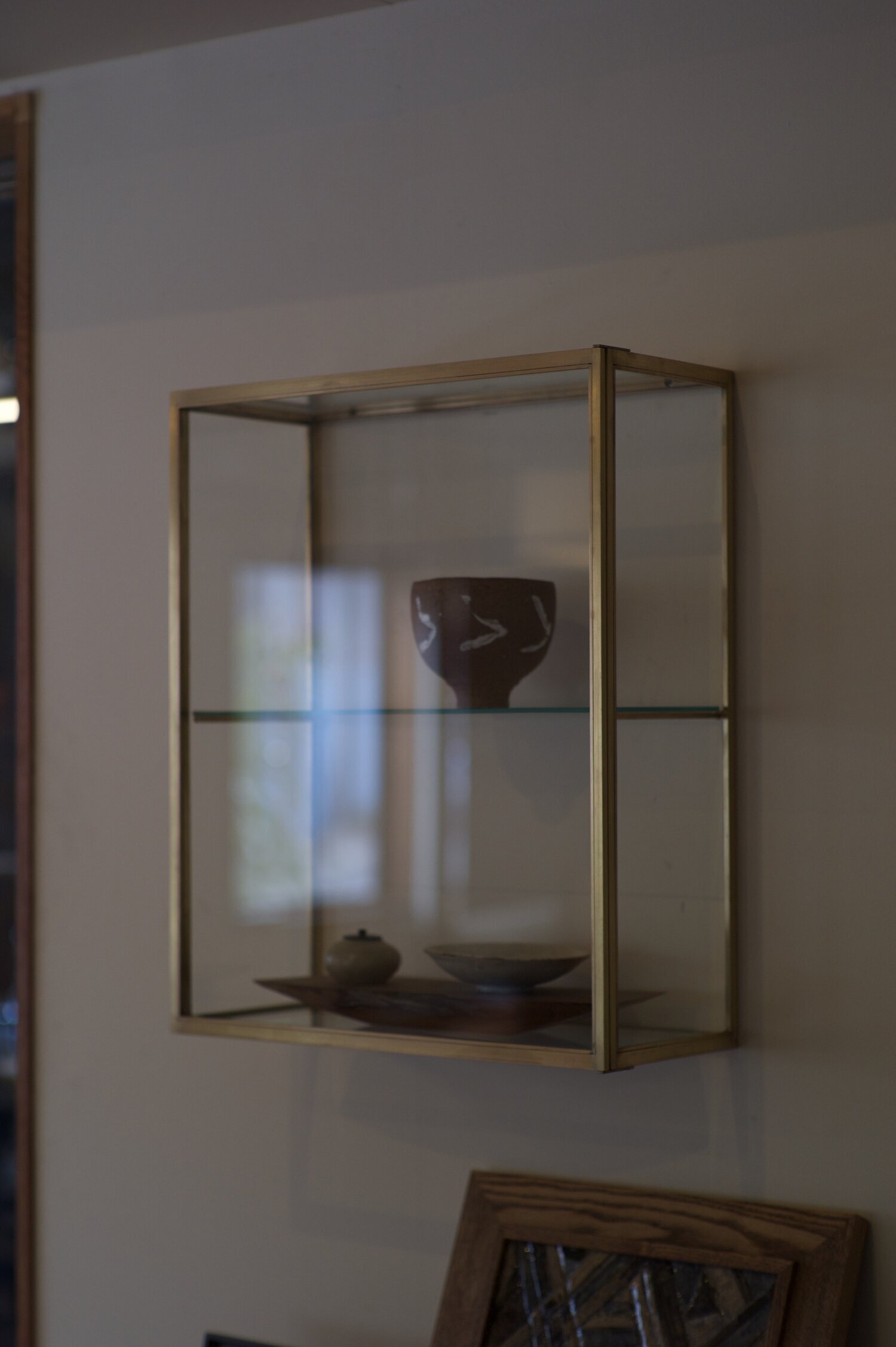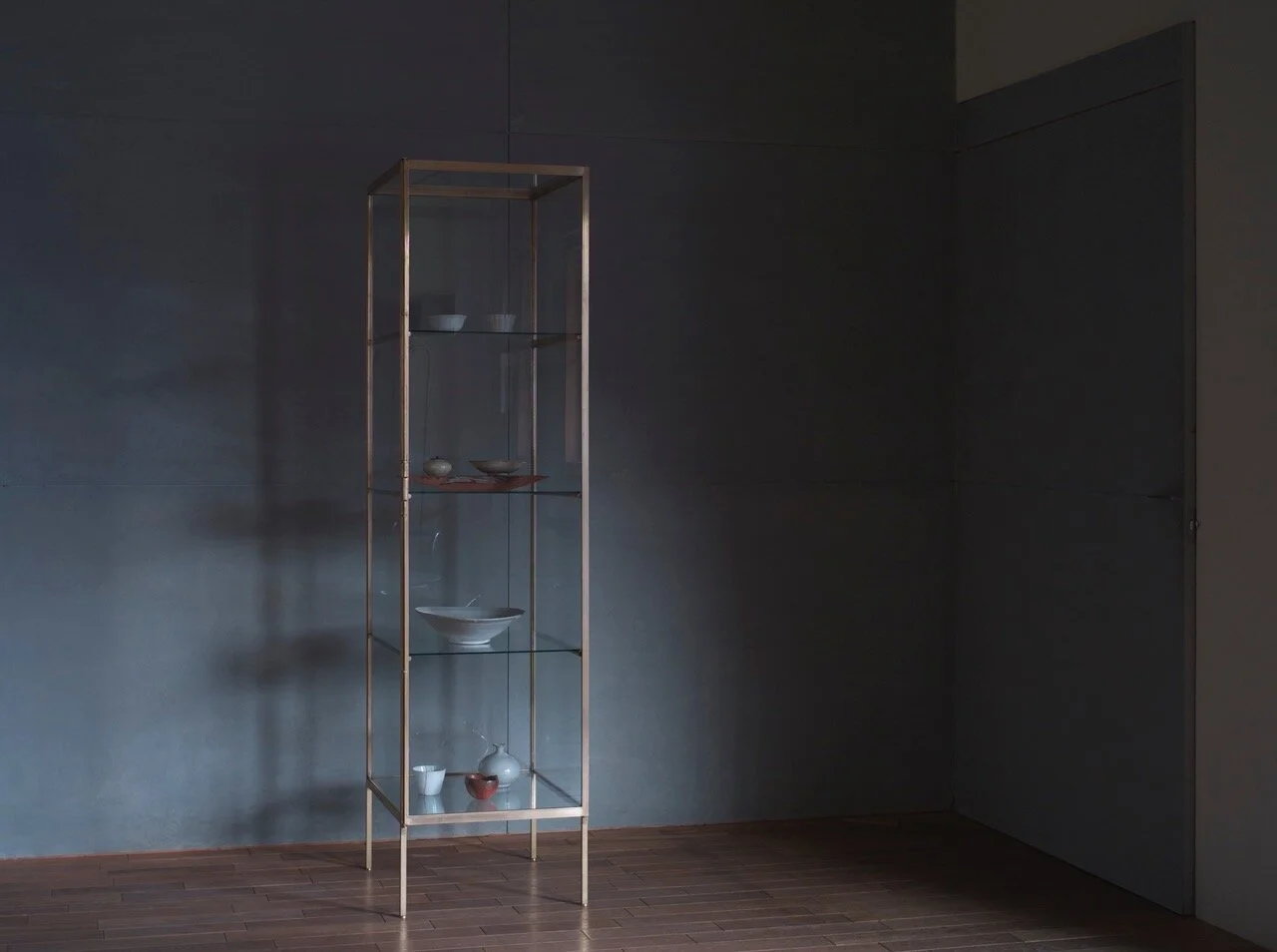Interview with TAKASHI KITA/KITA WORKS —part 1
1/2
furniture should have practical strength. Also, I thought it's useless to be any thicker than necessary.
— Takashi Kita / KITA WORKS
photography : KITA WORKS
words : Reiji Yamakura/IDREIT
We interviewed Takashi Kita, the director of KITA WORKS, about the brass-made cabinet that he showcased at his solo exhibition at gallery MÜTTE, and his design philosophy. He established KITA WORKS based in the family-operated welding factory in Okayama prefecture in 2009 and has been working on the designing and manufacturing of original furniture.
The series of brass cabinets were made for his solo exhibition "KITA "Brass" at Gallery MÜTTE in Okayama City. The height of the double door cabinet is 1600mm.
— First of all, what triggered you to start creating furniture?
After acquiring metal processing and welding skills at Kita Welding Factory that my father founded, I thought back in 2007 that I wanted to create furniture for my own place, and so I made a desk and a cupboard. Up until then, my work was revolving around the manufacturing of machine parts, so creating something that I use on a daily basis was refreshing, and fun for me.
— For the material, did you use steel?
Back then I was fascinated by wood, so I’ve learnt carpentry from my friend, and then used wood and steel to create my items. For the designs, I’ve studied it on my own, but it was fun to design things that I would be using, and it was fun to create them while trying out various methods, so eventually I started creating furniture by occupying a corner of the factory. After that, I’ve decided to set the furniture and household goods creation as the core of our business, and so I’ve renamed our company to KITA WORKS in 2009.
KITA WORKS manufactured a slim single-door cabinet using thin components. The height is 1650mm.
Two types of brass-made wall cabinets were produced: one with glass and one with brass doors.
— Could you take me through how you’ve ended up showing the brass-made cabinet at your solo exhibition in 2020?
It began when the owner of a gallery, where I once did my personal exhibition, invited me.
This owner knew how I had been working on creating items using brass, and he suggested I make a brass cabinet. I did create small items like door handles using brass in the past, but I had been declining requests to create complex items due to its technical difficulty. But I did have the desire to one day create large items using brass, so when the owner suggested it to me, it raised the spirits of craftmanship in me. It ignited my will to go for it, and so I began creating the brass cabinet like crazy.
— What is so difficult about processing brass?
Since brass is an alloy, you need to insert glue-like substance during the welding step to fix them together, but when creating a cabinet, you need to weld parts at one point from 2 different directions, which can be tricky. But then I’ve seen brass-made cabinet in the past that was made in Europe, so I already knew it isn’t technically impossible, so I made prototypes many times, I worked hard on it, and kept on solving challenges.
— Any particular points you consider important about the designs?
This does not only apply to cabinets, but I usually think furniture should be made strong enough for practical use, but at the same time, it's useless to be any thicker than necessary.
So, when creating this particular cabinet, I used thin materials as much as I could. I’ve created 5 types of cabinets in total for this exhibition; one with double doors, two with a single door, and two with wall shelves, but to keep all brass parts as thin as minimally required, I used materials with different diameters; 12mm for small wall shelves, and 15mm for large cabinets. Even if they look beautiful on the outside, it’s not good if they break down easily, so I paid special attention to the practicality and strength of all the cabinets.
For the double-door cabinet, the door frames were designed to overlap in the center.
The door locking mechanism is also custom made, with sophisticated brass parts.
— The centre part of the doors on double door cabinet looks very beautiful, but how did you work on that part?
This is the part I’ve paid extra attention to. For the part where the 2 doors close next to each another, if the thickness of the door frame is 15mm, then the total thickness of the frame at the centre will be 30mm if I made this cabinet in a normal way. Since I wanted to make it look delicate, I designed it so that when you look at it from the front side, these 2 door frames with 15mm thickness will come on top of one another. Also, I developed the original lock mechanism with a tiny knob that can rotate 90 degrees.
— Wow, that lock was also originally made!? The colour of that brass looks good, too.
Brass has this original shininess to it when light hits it, and its dull texture is distinctive and beautiful, and it looks good as it changes over the years. Brass itself has this appeal to us that is completely different from brass colour paint. During the exhibition, Shinichiro Nakahara, a founder of Landscape Products, really liked my cabinet, so he used it at his own exhibition in Tokyo later on. Also, we have a plan to hold my exhibition at MÜTTE for 3 consecutive years, so I am currently working on its preparation towards next year.
A custom made steel window frame for the French restaurant FEE DES NEIGES in Tottori City.
— That’s very exciting! Could you tell me about the custom-made steel window frame you did for the French restaurant FEE DES NEIGES next?
A few years before, I was ordered to create their window frames from the restaurant owner as part of their renovation work. This window consists of 8 glass panels in total, with every second glass window opening towards the outside. It has the same concept with the brass cabinet doors, so when the windows close, their frames overlap one another and that makes all the vertical lines look like they are equally aligned.
The window frames were designed to be as thin as possible. There are eight pieces of glass, four of which open outward.
All the stoppers and screws under the windows were custom made.
— It gives a very sharp impression to the whole design as a result.
I tried to choose the materials that look delicate, and I put some effort to make sure the fixed window panels and the opening panels look aligned when you close them. I applied the same technique I used on the doors of the cabinet here. Also, if I used mass-production stoppers and fixing screws under the window, it did not look suit and well-balanced, so I manufactured them on my own.
continue to part 2






















